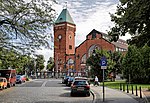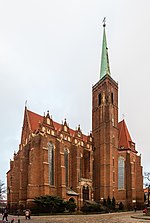Church of St Mary on the Sand
Churches in WrocławGothic architecture in PolandPages with listed invalid ISBNsRebuilt buildings and structures in WrocławRebuilt churches in Poland

The Church of St. Mary on the Sand (Polish: Kościół Najświętszej Marii Panny na Piasku, German: Kirche Unserer lieben Frau auf dem Sande, Sandkirche) is a Catholic church in Wrocław, in Silesia, located on a small island in the Oder River, in the heart of the city. Founded in the 12th century, it is one of the oldest Gothic churches in the country.
Excerpt from the Wikipedia article Church of St Mary on the Sand (License: CC BY-SA 3.0, Authors, Images).Church of St Mary on the Sand
Geographical coordinates (GPS) Nearby PlacesShow on map
Geographical coordinates (GPS)
| Latitude | Longitude |
|---|---|
| N 51.1147 ° | E 17.0411 ° |








